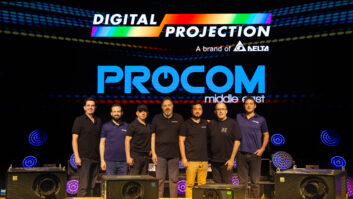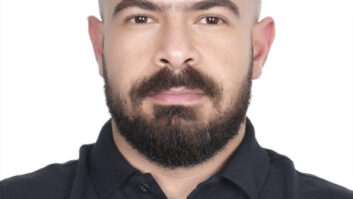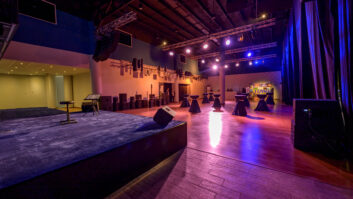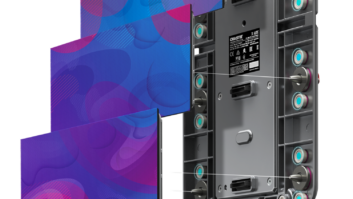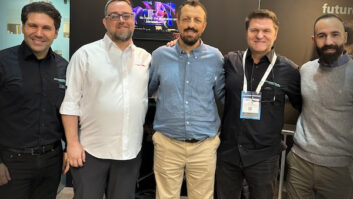It just goes to show how significant the physical layout of exhibitions can be. Just like at the inaugural event last year, InfoComm Middle East and Africa 2012 was co-located with IT trade show GITEX in Dubai’s World Trade Centre. GITEX is huge: it drew 130,000 visitors last year, and the crossover between the two events helped to bring InfoComm MEA’s total attendance to over 12,000. The entrance to InfoComm was close to the entrance to GITEX.
Fast-forward 12 months, and InfoComm MEA 2012 was located right at the far end of GITEX. The show had its own dedicated entrance, and could also be entered via what was apparently one of the less exciting GITEX halls – full of small stands and national pavilions rather than big brand names.
The result was that the show was noticeably less well attended than in 2011. Just about every exhibitor we talked to remarked on this – although not all of them said they were disappointed by it.
On a more positive note, there were no adverse comments about the quality of the attendees: many companies said they were pleasantly surprised by the level of company and even product knowledge shown by visitors to their stands. In addition, many were end customers or integrators looking for solutions to use in particular projects, rather than simply gathering information.
The show’s geographical reach was also praised, confirming Dubai’s status as a hub location. As well as the Middle East visitors, the show drew visitors from African nations: Intelligent Lectern Systems reported doing a deal with a Nigerian visitor for one of the models on display on its stand.
Eric Brouwers, regional director Middle East & Africa at Barco, told us: “We used to be in GITEX, but InfoComm is a much better place to meet our peers, so we moved across last year. I think it was a smart move – but this show has to grow.”
Over at GITEX, Simon Smith, who runs Christie’s Dubai office, was bullish about his decision to move back to the IT show after exhibiting at InfoComm MEA 2011. “We’ve had more leads today than at the whole of the show last year,” he said.
Another manufacturer with a dedicated Middle East office is TC Group. Marketing manager Mark Millar sees the Middle East market as very important to the group, especially the Tannoy and Lab.gruppen brands. “We have been very fortunate to have been involved in some very prestigious installs out here, which has definitely raised the profile of the brand in this market,” he said.
Graham Lawton, general manager for Tannoy ME, believes there are definite benefits of having a local office in Dubai: “For instance we have installed in projects such as the Hard Rock Cafe in Festival City and more recently the newly opened ‘360’ club at Jumeirah Beach.” He added: “The new VX series, based on the evolution of the V series, is really making an impact out here, and on the amplifier side the E-Series from Lab.gruppen is doing the same.” Millar added: ”Club systems that may have had other historical preferences are now being converted after hearing the sound from our new products.”
@page_break@Forward outposts
If, as Randy Lemke of InfoComm International told us recently, tradeshows are forward outposts for his organisation, the same is true those exhibitors without any kind of local presence. One exhibitor that told us it would rebook next year was Lightware(pictured), although David Jones from its UK office said that it might book a stand in GITEX as well. The company used the show to launch its MODEX range of modular extenders in the Middle East. MODEX offers a full range of modular transmitters and receivers extending digital and analogue video and audio, USB KVM, Ethernet and control signals over a single fibre or Cat/6/7 cable. More than 5,000 extender variations are available, and 3D and 4K video resolution are supported.
Most of those we spoke to felt that the Middle Eastern AV market had returned to more or less the level that it had been before the crash of a few years ago – albeit with a little more restraint in the scale of construction than was the case back then.
The Middle Eastern market continues to generate major projects. The larger ones can create a spike in manufacturers’ revenue patterns and also may be delayed at short notice – making forecasting something of a headache.
The way in which projects are organised and structured means that specifications can be fluid: if a manufacturer’s equipment appears on the original specification, that is not a guarantee that it will appear in the final build.
“Getting swapped out of a spec happens more often here and in Asia than in Europe,” commented Steve Scorse of Prysm. “Often it’s because an influential person makes a last-minute change, rather than for reasons of budget.”
Prysm benefited from this at its flagship installation in the region, at Dubai TV, which came about as the result of a technology demo that took place after rear-projection cubes had been originally specified.
Many exhibitors highlighted the education sector as an area of focus. For Biamp, Dane Miller said that Saudi Arabia is the standout country in the region for the company, thanks to a major university project in Riyadh. However, the company was gaining traction in Qatar, while the UAE is harder but with “some light at the end of the tunnel.”
Biamp showcased all its main product lines including the Tesira scalable media system for digital networking using audio-video bridging, and the Vocia paging system. In addition, it announced the latest version (1.4.1) of Vocia’s software. One of the new features is that the maximum delay times on the VA-8600/VA-8600c amplifiers have been extended from 0.5 seconds (500ms) per channel to 2.7 seconds.
We featured two recent Middle Eastern deals for DIS in last month’s Installation, and according to area sales manager Christoph Hellmuth, the company has had sales success recently in Iran, Jordan, Egypt, Algeria, Tunisia and Morocco. On its stand, the company focused on its 5900 system and its new ready-to-go camera and microphone control package – the CP7851 – as well as showing its 6000 series. The Digital Discussion System DDS 5900 consists of a central unit and a single programmable multi-user unit. Every unit is configurable as either a delegate or chairman unit and can be configured for two-language interpretation. The CP7851 is a complete camera control package for easy integration with the DCS6000 Digital Conference System.
@page_break@Rising turnover
According to international sales manager Aaron Lange, Gefen’s turnover in the Middle East is rising at 30% year-on-year. The company bought three new KVM (keyboard, video, mouse) over IP extenders to Dubai. Each model supports the connection of sender and receiver units through a LAN, allowing up to 100m of signal extension on the sender side and another 100m on the receiver side using one Cat5 cable. All three KVM extenders support audio, USB, RS-232 and IR connections in addition to DVI, HDMI or VGA for video.
Personal relationships are important in business everywhere, but Kris Vermuyten of Apart Audio placed special emphasis on them in the Middle East. “Knowing people is more important here than in Europe,” he said. “People need to have confidence in you – once they start using your product they remain loyal.”
The company was highlighting its VINCI Series and the new OVO5P active speaker series. VINCI 5 and VINCI 7 are reference bookshelf speakers. VINCI 5 and VINCI 7 bass reflex cabinet speakers produce a pure and detailed bass sound and have also superb control of mid-range and high frequencies. A new amplifier, the VINCI 2125, has also been introduced. Released earlier this year, the OVO5P is an active speaker set that consists of an active and a passive loudspeaker: a speaker set with clear voice reproduction and high sound level with 2 x 20W output power.
The show also attracted exhibitors completely new to the Middle East, such as display manufacturer EKTA (pictured), which has exhibited at ISE for many years but was showing its wares at InfoComm MEA for the first time. The company’s eye-catching stand had a large 9mm pitch LED screen augmented by a smaller 4mm pitch screen moving across it.
It wasn’t only manufacturers from Europe, the US and China that were looking to grow their business at InfoComm MEA. Arrive (with its subsidiary brand Rave Interactive) has its headquarters in Dubai (with R&D operations in China and India). Falguni Jesrani chief program manager, stated that the company’s business is very much in the Middle East, but it was looking to expand further afield.
Among the products on display on its stand was a multi-user (up to six people) multi-touch (up to 32 simultaneous touchpoints) interactive touchtable that could work with any plasma or LCD display – enabling end users to extract more value from existing screen inventory.
The Pathfinder A/D and QuickScout A/D XL were highlights on the TSL stand. Both devices are designed to route signals without compression or conversion and consequent loss of quality. The Pathfinder A/D conference room system, which can handle analogue or digital signals, allows up to 36 connected users peripheral access to a common LCD screen and data/video projector in Full HD resolution as well as to an audio amplifier and the LAN – by a simple push of a button.
QuickScout A/D XL can control playback devices by RS232, IR as well as screens and other 230V devices. By detecting the connected sources, or by the user pressing a button, the device puts a conference room in the optimum operating status. The analogue/digital switching of the display device is carried out automatically.
Taiden focused on its flagship Paperless Multi-media Congress System HCS-8300 series. This system adds state-of-the art IT technology to conference technology by developing the contribution unit into a versatile multimedia terminal.
The terminals are equipped with a 7in or 10in touchscreen and an integrated 3MP camera, allowing users to manage and control any meeting from the screen. Numerous functions are available from a terminal – such as contactless sign-in, discussion, voting, 64 channels of interpretation, speech text guidance, video intercom and Office Reader for paperless meetings.
@page_break@ Magenta Research used the Dubai show to introduce recent additions to its Voyager and MultiView lines. These included the Voyager 4-port transmitter which, when combined with the daisy-chaining capability of Voyager receivers, enhances the range’s signal distribution options. The four-port transmitter core works with any of Voyager’s video modules, which are offered in VGA, component, HDMI (with HDCP) and DVI modes. It is a key component in enabling Voyager fibre-optic based matrix switching to reach a maximum size of 640 total ports.
The Annuncicom VoIP and IP audio devices along with the Exstreamer IP audio decoders once again took centre stage on the Barix stand. The Annuncicom 60 and Annuncicom PS1 are both PoE-capable to simplify installations for integrators and end users, requiring only a single cable to connect to a network. The Exstreamer P5 and the Exstreamer 205 are said to be ideal as IP playout points for paging, public address and distributed audio streams.
Chinese conference systems manufacturer Gonsin is active in the Middle East, citing projects in countries such as Iraq and Saudia Arabia. The company was showing its Daya DCS conference system, which it launched last year. DCS stands for distributed congress system. According to international sales manager James Wang, the system is unique in its versatility: it can accommodate wired and wireless technology, and even web conferencing. It’s also possible to incorporate a multimedia control system.
D.A.S. Audio opted to highlight the white version of its Aero 8AW powered line array system. Also new is the Road series, which comprises a 12in and a 15in two-way powered stage monitors – the Road 12A and the Road 15A respectively. The monitors incorporate Class D power amplification and a switch mode power supply (SMPS). The amplifier offers 550W for the low-frequency way and 220W for the highs.
L-Acoustics showed its 5XT coaxial range and the ARCS WIDE constant curvature system. The 5XT is based on a two-way passive design with a nominal impedance of 16 ohms. The compact system contains a one-inch diaphragm compression driver coaxially loaded by a five-inch low-mid frequency transducer mounted in a bass-reflex tuned enclosure. The ARCS WIDE line source can be deployed as either a horizontal or vertical system. It is suited to achieving extensive coverage with few elements, offering a compact array that preserves sightlines.
BrightSign used InfoComm MEA to announce the industry’s first line of solid-state digital signage media players with PC-class performance – the XD. Jeff Hastings, BrightSign CEO, was suitably bullish about the XD’s potential in the marketplace. “We see the market exploding for this kind of product – no-one else can do it,” he said.
TV One, which exhibited on the booth of Oasis Enterpises, its partner in the region, showcased its C3-540 CORIOmaster and C3-340 CORIOmatrix. The C3-540 video processor features CORIO3 technology, which allows the use of layouts that define where each output is used. Outputs can be grouped together or individually and can be independently rotated through 360° in real time, without adding additional delay, for use in creative video wall applications. Projectors can be used off axis, with brightness controls used to make an even distribution of the projected image. Warping controls allow for projection on curved screens, and multiple layouts can be used at the same time.
Analog Way demonstrated a selection of its latest solutions. The Eikos multi-layer mixer scaler seamless switcher offers up to 12 inputs including four fitted with SDI and two fitted with DVI-D. Smart MatriX is a powerful scaled matrix with native hi-resolution output equipped with four scalers. It outputs digital and analogue signals in DVI and VGA (RGBHV) simultaneously with a selection of many formats from HDTV to Computer 2K.
Additional reporting by Ian Graham.
